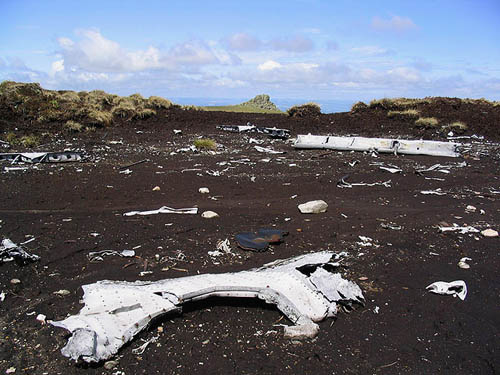Crash Site & Wreckage B17 Flying Fortress Bomber West Hill
The aircraft was B-17G 44-6504 of 360th Bomb Squadron [PU*M], 303rd Bomb Group, Eighth Air Force, Molesworth, Huntingdonshire.
Accident returning from a recalled mission to a railway marshalling yard at Stuttgart, Germany 16Dec44 (2KIA:7RMC).
Because of deteriorating weather conditions, the mission was aborted and the flight recalled. To prevent mid-air collisions, the formation of bombers was ordered to break rank and head for separate bases in England. On several occasions, the pilot of this B-17 requested bearings back to England, but was misled by false signals from German transmitters. This resulted in the aircraft flying too far north of the English bases. Eventually, while flying close to the Scottish / English border, the pilot descended through the clouds in an attempt to establish visual bearings, severe icing having been experienced at heights greater than this. Unfortunately, however, the pilot descended too low to clear the snow covered Cheviots. The aircraft crashed in blizzard conditions into the side of the 2,600 foot West Hill narrowly missing a rocky outcrop known as Braydon Crag of the Cheviot mountains near Alnwick, England. It then slid across a peat bog, coming to a halt on the hill shoulder. The nose of the aircraft had been completely crushed killing the two occupants; the pilot was seriously injured when one of the propellers smashed through the cockpit breaking his jaw. Surviving injured and dazed crewmen were discovered by a Border Collie sheepdog named Sheila who then summoned and guided her owner and his neighbour to the crash site where the crewmen were rescued. When the bomber crashed, its bomb load was still intact. Fortunately, these munitions had not exploded on impact with the ground, however, just as the crew reached the safety of the shepherd's cottage on lower ground, the entire bomb load exploded.
The shepherds were awarded the British Empire Medal and Sheila received the animal Victoria Cross (Dickin Medal). The bereaved mother of the togglier wrote a thank you letter to the shepherd stating that she would like to purchase a pup from Sheila if she ever had a litter. A few months later Sheila obliged and the first of the new pups was dispatched by the R.A.F. to Columbia, S.C. as a gift to the togglier’s mother. The pup, called Tibbie, lived for eleven years and was adopted as the town pet of Columbia.
An engine, with a fuel tank and other parts, is on display in the Bamburgh Castle Aviation Artefacts Museum, Bamburgh Castle, Northumberland, England.
Do you have more information about this location? Inform us!
Source
- Text: Stewart Phixer
- Photos: Walter Baxter




